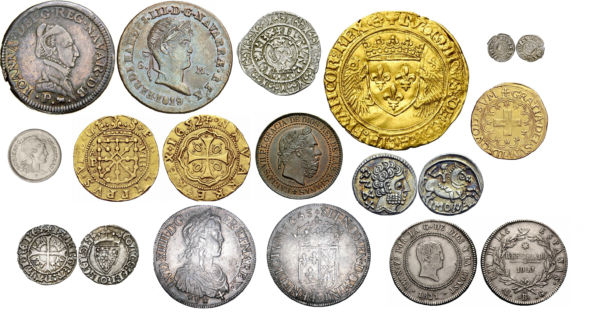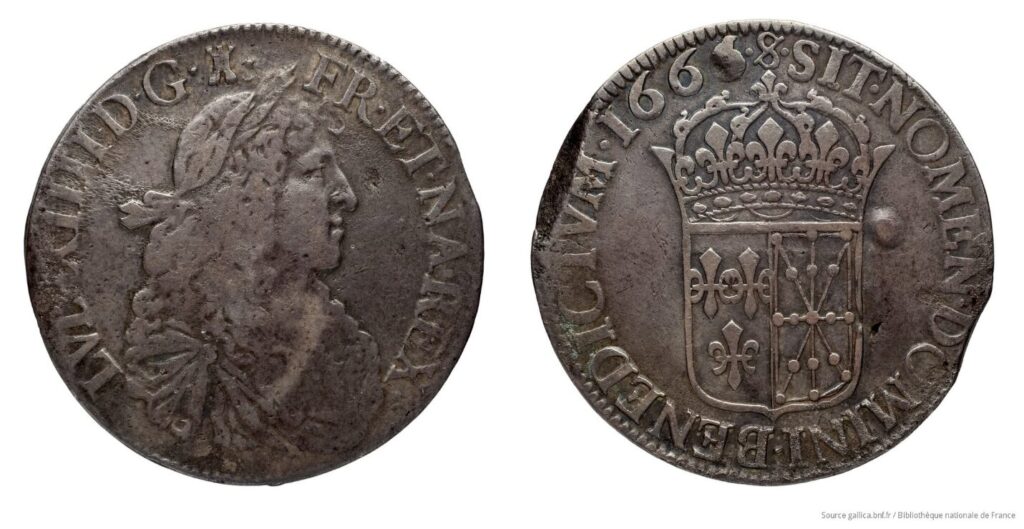Although Louis XIII annexed Lower Navarre and Bearn to the Kingdom of France in 1620, these territories (closely linked to Louis XIII's father, Henry IV) continued to maintain special privileges until the French Revolution. However, as we will see, in the monetary field, the number and scope of these privileges began to decrease from 1662 onwards.
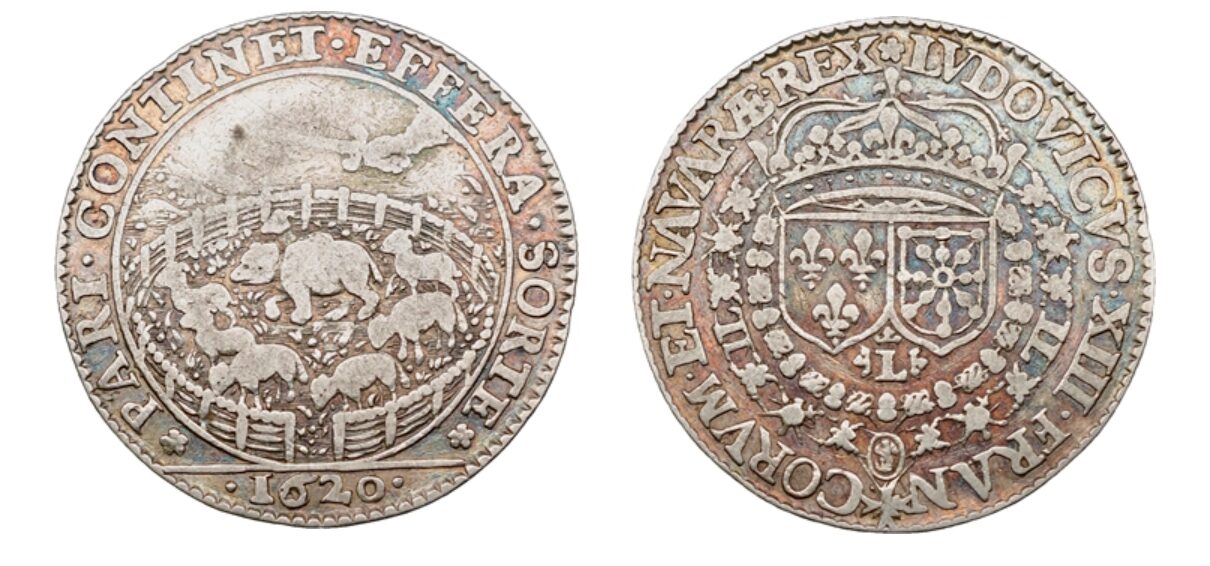
Silver jeton minted in 1620 representing the unification of the territories of Bearn and Lower Navarre with France (minted in Paris) – 5.34g – 27.0mm – A bear in an enclosure full of sheep. Above the bear, a sword-wielding arm emerging from the clouds threatens the bear.
Obverse: PARI. CONTINET. EFFERA. SORTE (Locks them in the same cruel fate)
Reverse: LVDOVICVS. XIII. FRAN CORVM. ET. NAVARAE. REX
Inumis Sales House
When the King of Navarre, Henry III and later Henry IV of France, took the French throne in 1589, the territories of Lower Navarre and Bearn were not incorporated into the French crown.
In 1607, Henry IV annexed to the French crown all the feudal territories of France that had long been under his family (Foix, Bigorre, Albret, Rodez, Armagnac and others). However, the sovereign territories of Lower Navarre and Bearn maintained their distinctiveness and legal autonomy. He re-authorized the Catholic religion in these territories in 1599, and from then on both Catholicism and Protestantism were accepted, but he did not enforce the Edict of Nantes in the Kingdom of Navarre. The Huguenots still controlled the institutions surrounding the rule and these territories maintained a special legal regime separate from the Kingdom of France.
After becoming King of France, Henry IV never returned to Lower Navarre or Bearn. For this reason, the king, who lived in Paris, was represented in Lower Navarre and Bearn by a viceroy. The power of this viceroy was considerable during the reign of Louis XIII, but with the personal reign of Louis XIV, it was reduced to a symbolic role. This viceroyalty, remained within the Gramont family for a long time, they were the viceroys of Bearn and Lower Navarre, Governors of Bayonne and the famous sovereign family of Bidaxune.
Before the first Protestant uprising, in 1620, Louis XIII decided to enforce the Edict of Nantes in the Kingdom of Navarre (Bearn and Lower Navarre). After arriving with a large army, he re-established the Catholic religion as the state religion. He also enforced the Edict of Nantes for the Huguenots of Bearn and Lower Navarre. After this, on October 20th 1620, Bearn and Lower Navarre were officially and legally annexed to the Kingdom of France.
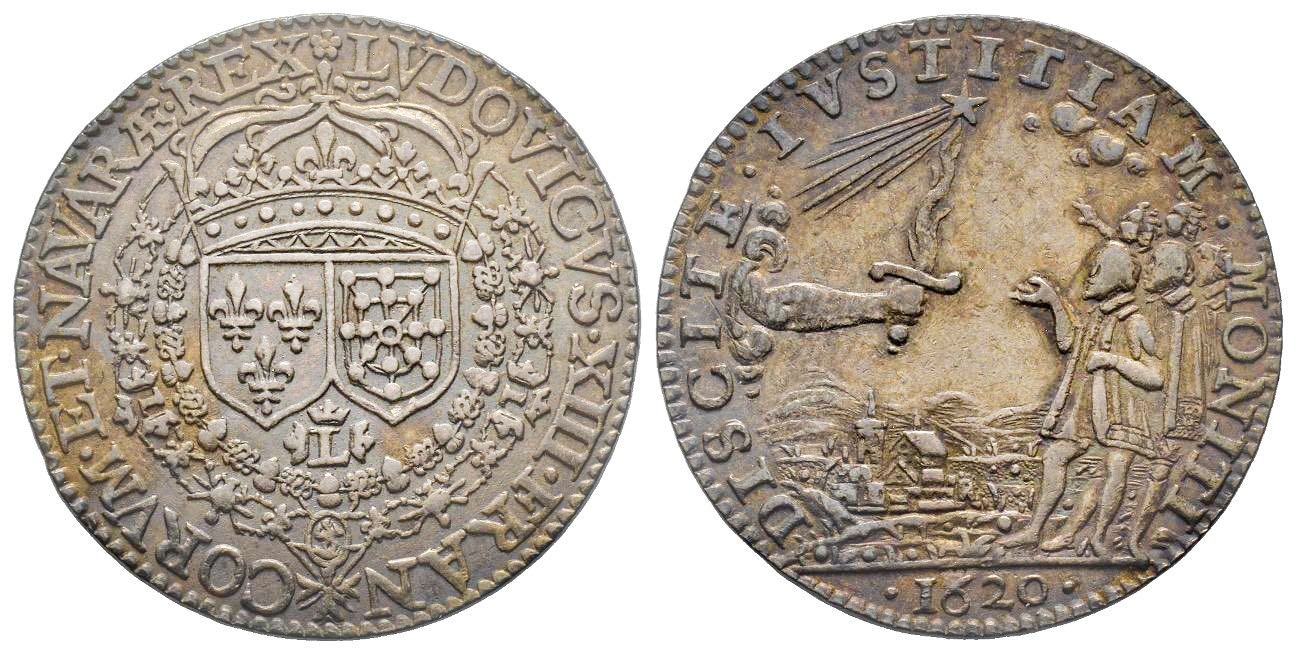
Silver jeton minted in Paris in 1620 representing the unification of the territories of Bearn and Lower Navarre with France – 27.1mm – approx. 7 grams – A hand emerging from the clouds of the sky grasps a flaming sword with a shining star; on the right are several figures standing before the sword. In the background is a city and a mountain range
Obverse: LVDOVICVS.XIII.FRANCORVM.ET.NAVARAE.REX.
Reverse: DISCITE.IVSTITIAM.MONITI.1620 (Learn Justice from this observation and be enlightened)
Monakotik Collection
In monetary matters, the mints of Lower Navarre and Bearn operated outside the jurisdiction of the Paris Monetary Court; instead, they operated as autonomous mints under the Navarrese Chamber of Accounts in Pau. Above the Navarrese Chamber of Accounts, they were subject only to the Parliament of Navarre and the Royal Council. As a result, disputes and controversies arose over monetary laws and regulations, in conflict with the mints of other French territories that operated under the regulations of the Paris Monetary Court.
Local customs remained in force. These customs were well summarized in the memorial presented to the king by the Chamber of Counts of Pau on February 11th 1620, in the months preceding the king's "visit" to Bearn.
The memorial highlighted that the mints of Lower Navarre and Bearn were under the special jurisdiction of the Navarrese Chamber of Accounts in Pau. The three mints, Saint Palais, Morlaàs and Pau, were leased to a master tenant for a certain number of years; then each of these three mints was managed by a sub-tenant or manager for each location. Furthermore, as the memorial indicated, the coins minted complied with the weight and purity standards of the French monetary system, although there were specific conditions specific to the region in the lease agreements. These special clauses often caused conflicts, both with the Monetary Court in Paris in general and with the highly competitive mint of Bayonne in particular, which complained that the vaguer Navarrese standards bordered on counterfeiting.
During the reign of Louis XIII, before the profound monetary reform of 1640, the mints of Pau, Morlaàs and Donapaleu only produced medium-sized silver coins, the quarter and eighth ecus. In fact, no gold or billon coins were produced during these years, the exception being the baquette a small local billon coin struck in Bearn and the double and single Tournai copper coins struck at Donapaleu/Saint Palais in 1635 and 1636. The silver minting of the Pau, Morlaas and Donapaleu mints ceased in 1632, and as a result, the watermill mint at Pau was closed for 18 years. During the first years of Louis XIV's reign (from 1644), the mints of Donapaleu/Saint Palais and Morlaàs resumed the production of silver quarters and eighths, using the previous hammer-forged techniques.
A new general lease contract for the mints of the French kingdom was signed in March 1645, and a new royal decree ordered the production of the new types of coins created by the monetary reform of 1640. This decree made mechanized coinage by rolling and screw press mandatory in all French mints, replacing the traditional hammer-based coinage. Bayonne Mint, was the last of the French kingdoms to abandon hammered coinage, and postponed until 1649 its transformation.

Silver Quarter Shield of Louis XIV, King of France and Navarre, minted in Bayonne – 9.57 gr – 29.5 mm
Obverse: LVDOVICVS.XIIII.DGFRAN.E.NA.RE.1649
Reverse: SIT.NOMEN.DOMINI.BENEDICTVM. Anchor.BL Emblem. L Letter – BL Letter, Martin de La Borde (1643-1656) Mintmaster. Anchor and L Letter Marks of the Bayonne Mint
1649 – Last appearance of hammered coins at the Bayonne mint
Monakotik Collection
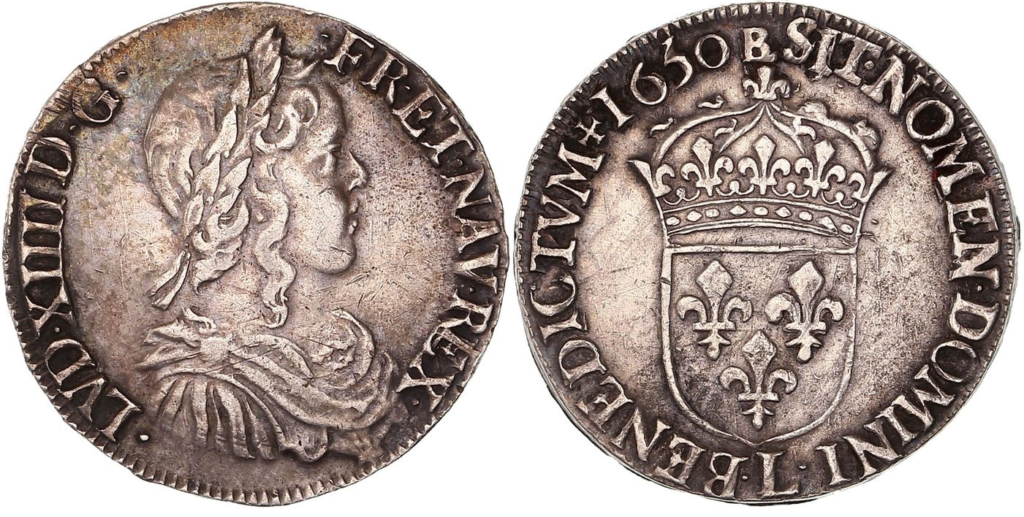
Silver Half Shield of Louis XIV, King of France and Navarre, struck in Bayonne – 13.54 gr – 32 mm
Obverse: LVD.XIIII.D.G.FR.ET.NAV.REX.
Reverse: SIT NOMEN DOMINI (L Letter) BENEDICTVM (Cross)1650 (BL Emblem) – BL Letter, mark of the mintmaster Martin de La Borde (1643-1656). Cross, mark of the engraver Guillaume Fons (1648-1656). L Letter, mark of the Bayonne mint
1650 – First appearance of coins struck by a screw press at the Bayonne mint – Monakotik Collection. 153,747 half-ecus were struck in this first year.
The Navarrese mints of Bearn and Donapaleu were forced to transform, they had no other choice.

Silver Quarter Shield of Louis XIV, King of France and Navarre, Struck in Donapaleu – 9.62 gr – 32 mm
Obverse: LVDOVICVS.XIIII.D.G.FRANC.ET.NAVA.R
Reverse: GRACIA.DEI.SVM.ID.Q.SVM.1651 V (V letter Jean Verdoye Mint master)
1651 – One of the last coins struck by hammer at the Donapaleu mint. There are supposedly two coins from 1652, but I don't have a photo of them.
Monnaies d'Antan, Auction 11, Lot 606 10.05.2012
The water-powered mint of Pau reopened in 1650, after a complete renovation of its mechanical devices. This mint had been fully mechanized since 1555, but the production of new coin series required a completely renovated larger screw presses and newer laminators. All these new devices were initially operated by the workers of the Morlaàs mint. However, these workers were skilled in hammering and the minting of this new period began with quality problems. After making the necessary investments, Donapaleu began to produce new coin designs using mechanization in 1652, and in the same year, the third mint of Morlaàs was also on par with the other two. This transformation increased tensions with the Monetary Court in Paris.
After the transformation into mechanization, the mints were able to keep the carbuncle that was the characteristic of the Kingdom of Navarre (and in the case of Bearn, the two cows of the coat of arms) on the reverse, but they were forced to abandon the motto "GRATIA DEI SVM ID QVOD SVM", first established by King Henry II "the one born in Sangüesa", and adopt the motto "SIT NOMEN DOMINI BENEDICTVM", which was common on the silver coins of the Kingdom of France.
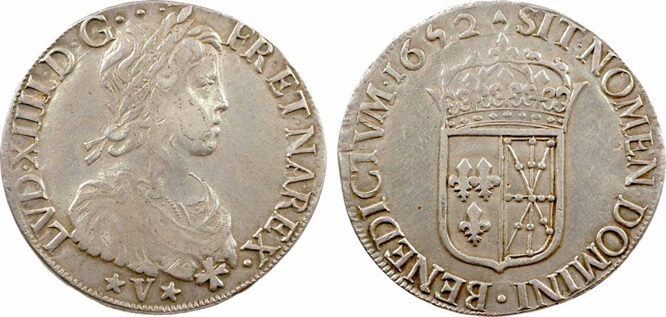
Silver shield of Louis XIV, King of France and Navarre, Strück in Donapaleu/Saint Palais – 26.87 gr – 39 mm
Obverse: LVD.XIIII.DG…FR.ET.NA.REX V (V letter Jean Verdoye mintmaster)
Reverse: SIT.NOMEN.DOMINI.BENEDICTVM. 1652 (Heart) (Heart mark of engraver Simon d'Armagnac)
1652 – One of the first coins minted with a flywheel press at the Donapaleu mint.
iNumis, Mail Bid Sale 17, Lot 508 23.03.2012
After the mechanization of the mints, the Chamber of Accounts of Navarre in Pau awarded Pierre de Peyré the general contract for the lease of the three mints. Peyré himself worked through subcontractors: he entrusted the activities of Morlaàs to Gassie and those of Donapaleu to Jean Verdoyé. Verdoyé himself temporarily supervised the activities of the Pau mill, until the arrival of Jean de Forcade. However, the quality of the coins produced during these years was often low, as many specimens can be found with defects in the silver lamination or with a weak imprint of the royal face.
The next part of the conflict has its origins in a decree of the French mint authorities in 1653. This decree prohibited the production of whole silver shields of 60 sous throughout the kingdom. Peyré and the Navarrese/Bearnaise mints working under his command ignored the order. They were said to be autonomous and did not have to obey the Paris Monetary Court. Consequently, faced with competition from the three mints next to it, the Bayonne mint also did not comply with the Paris Monetary Court's order.
The Monetary Court in Paris condemned the behavior of the Bayonne mint in April 1654. Jean de Laborde, the mintmaster of the Bayonne mint, argued that his actions were the result of unfair competition from the mints of Pau, Morlaàs and Donapaleu. However, on June 30, 1654, the Monetary Court prohibited the production of whole shields in Bayonne. It also denounced the behavior of the mints of Lower Navarre and Bearn in front of the royal council, requesting that the same monetary regulations be imposed on these territories as those of France. From then on, the Monetary Court in Paris constantly demanded the closure of the Navarrese mints.
Once again, the mints of Lower Navarre and Bearn ignored the prohibition of the Monetary Court dated on 30th June 1654. Over the years, between 1654 and 1658, the only whole silver shields worth 60 sous produced within the French monetary system were those struck in the three mints of the Kingdom of Navarre. When the Peace Treaty of the Pyrenees was about to be signed, in 1659, the French court moved to Bayonne and Saint-Jean-de-Luz. Consequently, in order to finance the expenses of the agreement, Bayonne Mint received permission to re-struck silver shields worth 60 sous. Baionako txanponetxeak.
The mints of Lower Navarre and Bearn responded by taking another step further, altering the precision of weight and silver content and producing coins of lower quality. With these tactics, they reduced the competitive power of the Bayonne mint, and in 1660, after the peace conference, the Navarrese mints regained the monopoly of producing silver shields of 60 sous.
The Chamber of Accounts of Navarre renewed the general lease of the three mints on July 1st, 1659; from then on, the three mintmasters, Gassie, Forcade and Daudichon, would be under the general supervision of Daniel d'Arripe. As we will see, from 1659 to 1662, the production of the Navarrese mints was once again turbulent.
Due to their competition with the Bayonne mint, the Navarrese/Bearnaise mints significantly increased their coinage during these years. Silver shields showing the coats of arms of Bearn and Navarre were widely distributed throughout France, including Lyon, where the authorities confiscated samples of poor quality Navarrese coins on 26th November 1660. In January of the following year, 138 samples were examined and all were rejected, on the grounds of lack of weight, insufficient silver content and defective workmanship. The Monetary Court of Paris issued a decree on 17th February 1661, prohibiting the use and possession of Navarrese-Bearnaise coins in the Kingdom of France, under penalty of death. Once again, it also asked the king to close the mints of Lower Navarre and Bearn.
This time, Louis XIV sided with the Monetary Court of Paris and signed a decree on March 17th, 1661, ordering the immediate closure of the mints of Pau, Morlaàs and Donapaleu. He also ordered that all the coinage accounts produced in the Navarrese mints since the time of Henry IV be sent to Paris. Fortunately (unfortunately in the case of accounts, as many of the accounts left in Bearn were later lost), this decree was not carried out, as the king used the prosecutor general of the Monetary Court of Paris to transmit the order instead of using the Navarrese Chamber of Accounts in Pau, which delayed the procedure until mid-1663.
This delay allowed the Navarrese and Bearnaise mints to continue their activities until, in December 1662, the local authorities ordered the temporary closure of the Pau mint. The reason for this closure was allegedly a fraud committed by the mintmaster, Robert Fisson.
While these exchanges were taking place, defective Navarrese and Bearnaise coins were included in the silver to be given to England in exchange for the purchase of the city of Dunkirk; when the English confirmed that they were defective, they caused diplomatic upheavals, increasing the anger of the French court.
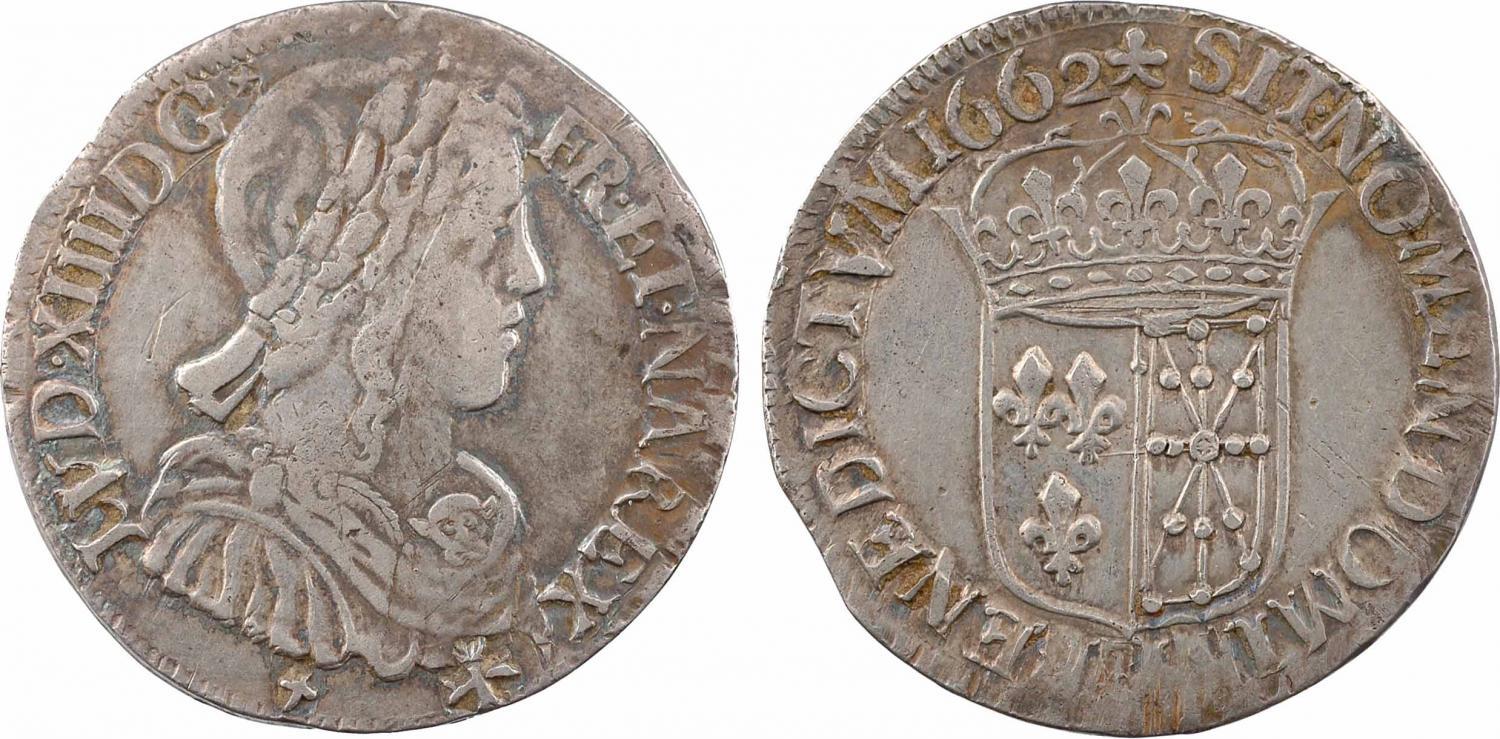
Silver half shield of Louis XIV, King of France and Navarre, struck in Donapaleu – 13.36 gr – 31.4 mm
Obverse: LVD.XIIII.DG * FR.ET.NA.REX (Little Clover) (Little Clover mintmaster Jean de Forcade)
Reverse: SIT.NOMEN.DOMINI.BENEDICTVM. 1662 (Clover) (Clover engraver Pierre d'Armagnac)
1662 – One of the last coins minted before the first closure of the Donapaleu mint.
iNumis, Mail Bid Sale 40, Lot 293 06.03.2018
Jean Baptiste Colbert replaced Nicolas Fouquet as finance minister in 1662. Immediately after taking office, he reorganized the French mint system. The Royal Council issued a decree following a report by Colbert, in which they supported Denis Genisseau, the general manager of the French mints. Genisseau complained that the mints of Donapaleu (Lower Navarre), and Pau and Morlaàs (Bearn) were resisting attempts to close them, and he asked the Council to confirm the order to close the mints.
Before this, on May 17th of the same year, Colbert had granted Genisseau the general lease of the French mints, changing the previous customary regime in which mints were leased individually.
The Paris Monetary Court reluctantly approved the new type of lease on 7th of July. Among the terms of the new contract was the reduction of the number of approved mints from ten to six, Paris, Rouen, Lyon, Bayonne, Rennes and Aix-en-Provence; the remaining mints, as specified in a decree of 14th June, were closed under Genisseau's orders.
Genisseau's orders were quickly carried out, and by the autumn of 1662, only six mints were operating in French territories; but the three mints in Lower Navarre and Bearn were a different story.
The general rental contracts of the French mints signed in previous years, such as those of 1645 and 1659, did not apply to the mints of Lower Navarre and Bearn. For example, a decree of 1648 established special conditions for these regions to allow the technical changes required by the new coinage reforms to be implemented, while maintaining their specific organization.
However, Genisseau interpreted the 1662 lease contract differently, claiming that the mints of Lower Navarre and Bearn were part of the French system and part of his contract. This interpretation was in line with Colbert's centralization agenda, as he had been the head of the kingdom's Finance Department since September of that year.
Genisseau sent his lawyer Moncheny to Pau to enforce the order to close the mints. Upon arrival, Moncheny was unable to register the order to close the mints in the office of the prosecutor of the Navarrese Parliament. The local authorities refused to accept the order, and after two weeks, Moncheny set off for Bayonne, where he registered his protest on 3rd October 1662.
This time, the royal council responded quickly and harshly. The closure order issued the previous year had not been carried out and in recent months, the scandals about the poor quality and weight of the coins of Bearn and Navarre had been constant. In a judgment issued on November 23rd, 1662, it ordered the immediate closure of the three mints of Donapaleu, Pau and Morlaas, prohibiting all coin production; otherwise, it would prosecute the managers and workers of these mints on charges of counterfeiting coins (it should be remembered that counterfeiting coins carried the death penalty in those days). It also ordered all the machines used for coin production (mills or laminators, cutters, screw presses, etc.) to be dismantled and locked up, in order to render them unusable. It also charged all the justice officials of the royal house with the responsibility of informing the managers and workers of the three mints about the content of the order. At the same time, it made the Navarrese parliament and the Chamber of Accounts responsible for the execution of the order, under threat of personal liability. Finally, the king argued and rejected the jurisdictional excuses of the Navarrese Parliament and the Chamber of Accounts, stating the immediate and undeniable obligation of the order.
After reading something like this, anyone would have thought that the Navarrese and Bearnaise people would have immediately said amen; the risks of overturning the king's will were becoming too great. But once again, that was not the case.
Genisseau sent another official, the legal representative of the Guyenne region, to ensure that the order to close the mints of Lower Navarre and Bearn was finally carried out. This official, accompanied by three witnesses, arrived in Pau on 19th December 1662. With the royal decrees in hand, he presented them to the chief prosecutor of the Parliament of Navarre and to the Chamber of Accounts of Pau.
Instead of carrying out the orders, the Navarro-Bearnaise authorities argued that the decrees required the formal approval of the Parliament of Navarre. Furthermore, tensions were greatly heightened when the workers of the local mints threatened the legal representative with violence. On December 22th, the Guyenne officers found the Pau mill closed, not by order of the king, but as a result of an investigation into fraud against the mintmaster Robert Fisson.
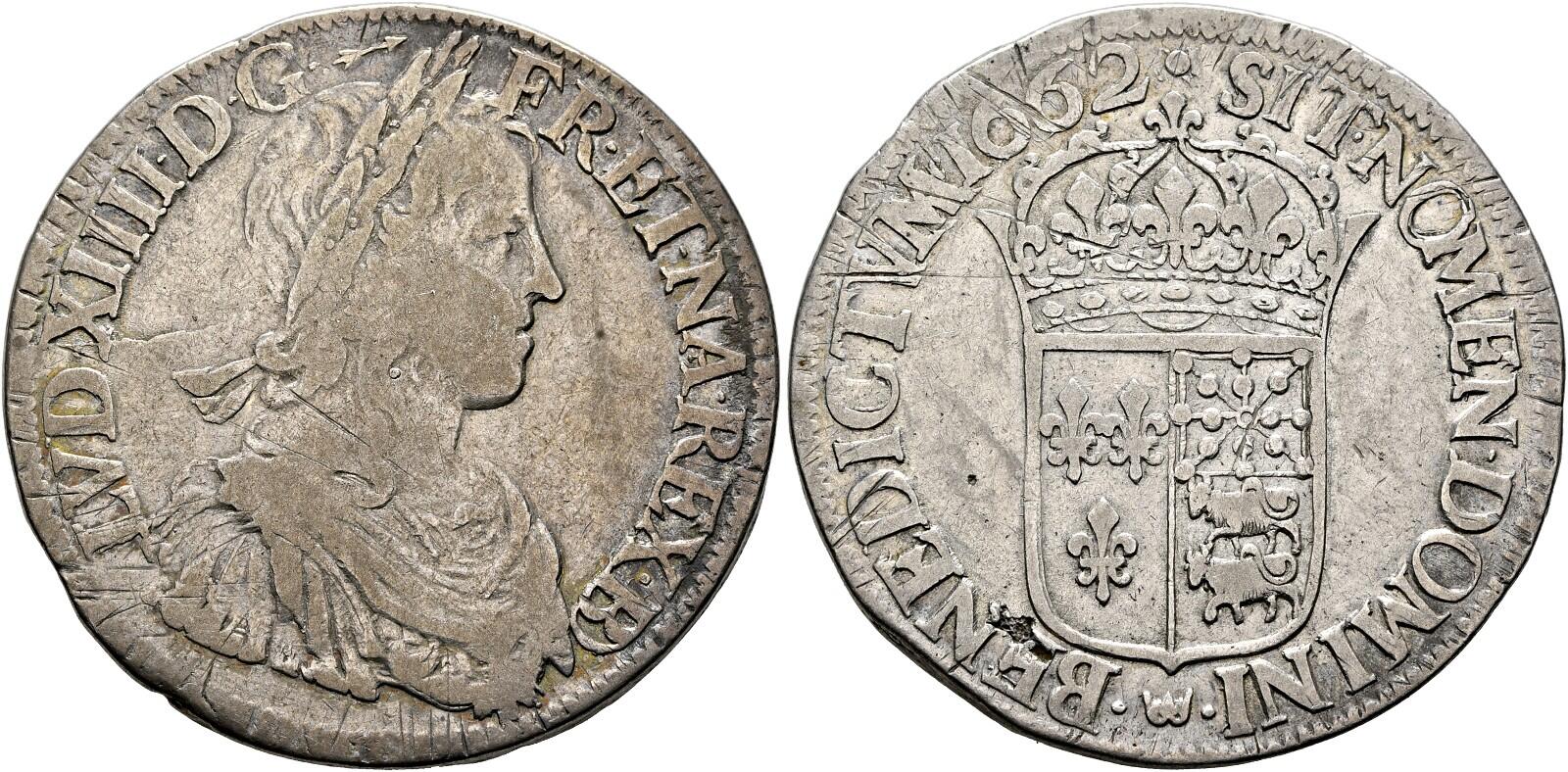
Whole silver shield of Louis XIV, King of France and Navarre, struck in Pau
Obverse: LVD.XIIII.DG (Arrow) FR.ET.NA.REX DB (Arrow, engraver Jacques de Soubiran)
Reverse: SIT.NOMEN.DOMINI. (crown).BENEDICTVM. 1662 (without final M mark, Mark of Pau Mint) (Crown, mark of the mintmaster Robert Fisson??)
1662 – This is one of the last silver shields minted before the first closure of the Pau mint. No more will be minted until the end of the following year.
Auktionshaus HD Rauch, Auction 116, Lot 415 15.06.2023
As the threats and violent attempts by the mint workers increased, the representative of Genisseau was forced to abandon his attempts to close the mints of Morlaàs and Donapaleu. He fled to Bayonne, where he completed his report, highlighting the coordinated defense and attack of the region and the lack of support from the Parliament of Navarre and the Chamber of Accounts of Pau.
The Parliament of Navarre issued a decree on 12th January 1663, in response to the attempt to enforce the king's orders. The decree confirmed the closure of the Pau mint, but clarified that this action was the result of investigations into the fraud of its mintmaster, rather than acknowledging the order of the royal council. The Parliament stated that the closure of the mint was temporary and had no connection with the royal decree.
In conjunction with the closure of the Pau mint due to the ongoing investigation, and due to the activities of the royal council and representatives of Genisseau, the mints of Donapaleu and Morlaas also suspended their activities.

Whole silver shield of Louis XIV, King of France and Navarre, struck in Morlaas – 26.90gr, 38.5mm diameter 917% silver content
Obverse: LVD.XIIII.DG (Arrow) FR.ET.NA.REX DB (Arrow, engraver Jacques de Soubiran)
Reverse: SIT.NOMEN.DOMINI. (crown).BENEDICTVM. 1662 M (M letter, mintmark of Morlaas) (Crown, mintmark of Robert Fisson??)
1662 – This is one of the last silver shields minted before the permanent closure of the Morlaas mint. After the closure of this year, the Morlaas mint ceased its five hundred year coinage history
CGB.fr, Live Auction December 2023, Lot 874366 05.12.2023
The Parliament rejected Genisseau's complaints, arguing that someone from outside had tried to undermine local autonomy. It insisted that the Pau mint would reopen under its traditional local organization and government, and that no royal decree should be issued without the formal approval of the Parliament. The decree, further highlighted the economic and social damage that the closure of the mints was causing to the province.
Given the seriousness of the situation, the Parliament of Navarre organized a petition addressed to Louis XIV, dated January 17th, 1663. This petition was prepared with care and diligence, aimed at the interest of preserving the stability of the region and the king's sense of justice. The text emphasized the historical and economic value of the coins in Lower Navarre and Bearn, as well as the loyalty of the local population, predicting the disaster that the policies promoted would bring.
This petition sets out the arguments to be presented to the king, arguing for the need to keep the mints of both Navarre and Bearn open. It developed twelve points:
1. Coins are significant and very ancient features of the Crown of Navarre and the sovereignty of Bearn.
2. In accordance with the laws and customs of the country, the king has maintained the Coins of Navarre and Bearn over time, so that the inhabitants of this province can exchange the foreign coins they acquire through trade, which avoids them being dependent on these foreign currencies (the reference here was mainly to the silver of the Spanish crown).
3. The abolition of local coins would lead to the ruin of Bearn and Navarre.
4. The coins of Navarre and Bearn have always been distinct from those of France, except in their weight and metal law, which are the same. The Parliament and the Chamber of Accounts exercise the functions and powers of a Monetary Court in Navarre and Bearn. In this sense, the act of unification of 1620 maintained their privileges in this area.
5. The attacks against the mints of Navarre and Bearn come from the mint of Bayonne, which wants to enrich itself at their expense.
6. The decision to close the mints of Navarre and Bearn, published by the Royal Council, was issued without first hearing the interested parties and based on false information, especially that received from the mint of Bayonne. The mints of Navarre and Bearn are not included in the rental contract of the manager Genisseau. An examination in October 1662 (after the contract signed by Genisseau) by the Chamber of Accounts of Pau of the drawn up production accounts of the years 1661 and 1662, is said to prove this point. The closure of the mints of Navarre and Bearn generates an annual income of 11,100 livres which are used to pay local taxes.
7. These minting accounts are in the hands of the Secretary of the Chamber of Accounts.
8. Genisseau posted posters in Pau and its surroundings in October 1662, announcing the content of the text of the Royal Council's decision; in which decision it was announced that the mints of Navarre and Bearn would be handed over to the Royal Council on the following 23 December.
9. Once again, it is recalled that the mints of Navarre and Bearn are not included in Genisseau's general rent of May 17, 1662.
10 and 11. Since the proceeds of the resources brought in by the mints of Navarre and Bearn are used to pay the local taxes of the country, the abolition of the mints of Navarre and Bearn would be a denial of resources to the country, contrary to the laws and customs of this sovereign territory. If the general contract were to be made in Paris, the country would be completely ruined, since it would not be able to pay the local charges and the officials would lose their salaries.
12. The complaint made by the officials of the Bayonne mint is invalid. If abuses have been committed in the mints of Navarre and Bearn, they must be punished by the officials of those mints and, where appropriate, by the Chamber of Accounts of Pau, which is responsible for the mint, or by the Parliament of Navarre, which is responsible for the trial of counterfeiting crimes.
The Navarrese knew that they faced a tough and powerful opponent and that the match would be close. Furthermore, to counter the influence of Colbert, whom they were hostile to, they sought the help of several important and influential figures.
To ensure that the request would reach the king, it was forwarded through the minister Guénégaud; a letter addressed to the latter suggests that there were already previous links between this authority and the Bearn parliamentarians. This request to the king was accompanied by a letter addressed to the chancellor Séguier, in which the Bearn people, the closure of the mints of Navarre and Bearn, highlighted the great economic disadvantages that the king would face if the mints of Navarre and Bearn were closed. Finally, The Duke of Agaramont and the Marshal of France, they also requested active assistance in this.
The Agaramos people served as governors or viceroys from 1624 until the French Revolution. The Marshal-Duke of Agaramos was a very important and powerful figure at court.
The support of these three leading figures was essential to defend and promote the aims of the Béarn-Navarres; let us recall that the creation of the general rent and its transfer to Genisseau were Colbert's invention, as was the closure of the three mints in Navarre and Béarn.
The intervention of these three figures in support of the petition to Louis XIV was successful. Perhaps the ruler was sensitive to the argument of the landowner about the disaster without a mint. On March 10, 1663, a decree of the Royal Council ordered the reopening of the mint of Pau and entrusted its execution to Genisseau. But the mints of Morlaas and Donapaleu remained closed; we will return to the details of this decision shortly.
A little earlier, before deciding to reopen the Pau mint, on February 22, 1663, the Royal Council accepted the request of the managers of the Bearn and Navarre mints to cancel their lease. The contract of this lease had been signed with the Chamber of Accounts on July 11, 1659, and they were required to pay a rent of 11,100 livres annually for a period of six years. The main signatory of this contract or lease was Daniel d'Arripe, but behind him were Jean de Gassi, Jean de Forcade (head of the mint of Donapaleu) and Jean de Daudichon.
Considering the bad outlook for their business, they asked the royal council to cancel the contract. The request was not made to the Chamber of Accounts of Pau, as they knew that this would reject the request, but to the Royal Council. The latter would not suffer any financial loss if the aforementioned rental contract were canceled, and was also laying the foundations for its subsequent decision.
So what were the details of the order issued by the Royal Council on March 10, 1663, to reopen the Pau mint?
First of all, we must say that the decision of the royal council did not mention the arguments of the Parliament of Navarre, it only referred to the complaints of the Bearn-Navarre ombudsmen. It therefore did not seek to legitimize the Navarrese parliament. Secondly, it was against the participation of any judge or court and issued its decision after another report by Minister Colbert.
This decision was based on the following explanations:
- Since ancient times, the coins of Navarre and Bearn were said to have been used to transform foreign silver into coins bearing the king's coat of arms.
- These mints were reportedly rented in accordance with the procedures of the local Chamber of Accounts, but for the last five or six months, due to Genisseau's efforts, they had not been working. These procedures were reportedly communicated to the tax collectors of the mints, with a view to appointing new managers and tax collectors.
- The closure of the mints caused significant economic damage both to the territory and to the workers who worked there.
After all this had been explained and subject to Genisseau's contract, the royal council ordered the reopening of the Pau mint, where coins of the form, weight and legality designated by the French coinage legislation would be struck. It therefore handed over the Pau mint to Genisseau, within the terms of the contract given to him, but it did not entrust the duty of registering the order to the coinage or currency court of Paris, but to the Chamber of Accounts of Pau.
In one way, the royal council recognized the specificities of the Pau mint, but from then on it had to work within the Genisseau concession. On the other hand, it recognized the powers of the Chamber of Accounts of Pau in the area of auditing accounts, but at the same time it removed its powers in the area of leasing mints.
The reading of the royal decree only ordered the reopening of the Pau mint. The mints of Morlaas and Donapaleut had to remain closed. On the other hand, if you read the decree carefully, it seems to order the end of the distinctive local coats of arms that were on the local coins, but this did not happen. Jean Warin, the engraver general of the French coins, received on June 9 the royal council's order to make punches and dies for the Pau mint and, as the few coins that have survived to our days show, the coining tools he made respected the local coat of arms and the title DB (Dominus Bearnie).
As for the coin samples or proofs that had been minted, who was now responsible for examining and approving these samples? Did the Paris Mint acquire this competence from then on or did it continue to be the Chamber of Accounts of Pau? The royal decree did not provide any clarification on this, but based on what happened, we can guarantee that the Chamber of Accounts of Pau retained this competence. Likewise, the punches and dies that Jean Warin had made for the Pau mint were not included in the register accounts of the Paris Mint, as was the case for other French mints.
After the council decision, which we can describe as Solomonic, we can have the idea that both the Paris Monetary Court and the institutions of Navarre-Biarno would have been somewhat satisfied, but this was not the case here either.
The Paris Court of Currency, in particular, developed a great deal of indignation and, following the order issued by the council to manufacture the punches and dies, on June 15, presented to the king strong complaints, unprecedented in the history of this institution. The content of these complaints is extremely interesting and is a complete reflection of the centralizing vision of the time. Here are the complaints submitted by the Paris Court of Currency:
- The Court of Coinage has universal jurisdiction, and its jurisdiction extends not only to the kingdom, but also to the countries, lands, and lordships that are under the king's obedience. This universality was desired by previous kings, as it is consistent with the welfare of the entire population and the needs of trade.
- In the past, whenever a province that had been a "Bourgeois" was annexed to the French Crown, it was placed under the jurisdiction of the Court of Currency.
- The only exception is Bearn, which is no more important than Brittany, Provence, Dauphiné, Normandy or Burgundy.
- Since the edict of 1645, the Court of Currency has made constant efforts to bring the mints of Bearn and Navarre under French law; since the reign of Henry IV, the coins of Navarre and Bearn have caused constant confusion. A prime example of the former was the payment made to the English for the purchase of the city of Dunkirk. Following the complaint of the Court of Currency, the Royal Council ordered the circulation of the coins of Navarre and Bearn to be stopped and the mint accounts to be brought to Paris.
- The Court of Coinage had expected that the number of mints in the kingdom would be reduced to six thanks to the lease granted to Genisseau, with the mints of Pau, Morlaas and Donapaleu being permanently closed. The Court of Coinage regrets the decision to reopen the mint of Pau and has notified the Chamber of Accounts of those territories. It fears that this will reduce the flow of the tax collector.
- The Pau mint is useless. It is always in competition with the one in Bayonne, and the one in Bayonne is said to be sufficient for the needs of the region. As the Court of Currency requires, if the Pau mint is reopened, it should henceforth be under its jurisdiction, instead of that of the Chamber of Accounts of Navarre.
- and 8. The Court of Coinage emphasizes the need for unity as the basis of the prosperity of the kingdom, where this unity must also be reflected at the level of the monetary structure; the same coins must circulate throughout the kingdom, subject to the same rules and judges, and these rules and judges must have their seat in the Court of Coinage. This principle has always been followed by all previous kings, starting with Francis I.
- and 10. Monetary responsibility is not an easy task. It requires proven competence, and this competence cannot be acquired overnight. That is why the Monetary Court was created as a sovereign, unique and specialized jurisdiction, and its members cannot perform any other functions than those assigned to the Monetary Court. The Chamber of Accounts of Navarre, whose members are engaged in other activities and only occasionally deal with monetary matters, cannot offer the same guarantees. The frauds and abuses that occurred in Navarre and Bearn are the result.
- The multiplicity of currencies is a source of confusion, the result of the intervention of several Parliaments in the field of coinage. The Court of Coinage reminds the King of the complaints made on this matter, which were the origin of the King's orders on coinage of December 1650 and March 1652.
- Finally, he recalls that the Court of Currency had supported the king during the Fronde uprising. However, he immediately points out that its complaints were only motivated by concerns for the public welfare.
These twelve points presented by the monetary court are very interesting and I wanted to present them in their entirety, because they show the clash and division of arguments between the unifying and decentralized tendencies that are still competing today. The inhabitants of our regions have been told this for a long time.
The Paris Mint, based on the initial decisions of the Royal Council, believed that it had put an end to the autonomy of coin production in Navarre and Bearn, but this decision to reopen the Pau mint completely frustrated its hopes and aroused its complete anger and fury. However, the king did not pay attention to these latest complaints. Times were changing and the Royal Council was accumulating power to the detriment of the Mint. In this case, however, the Mint did not have to submit.
The royal council had to remind Jean Warin of the order given to produce the punches and dies for the new coins of Bearn on November 9, 1663. In this case, Warin quickly obeyed, and thanks to the new punches and dies, before the end of the year, new silver coins of 60 sous began to be produced at the Pau mint.

Whole silver shield of Louis XIV, King of France and Navarre, struck in Pau
Found: LVD.XIIII.DG (Dove) FR.ET.NA.RE DB (The dove is the hallmark of the mintmaster, but his name is unknown, perhaps Louis Allerie)
Obverse: SIT.NOMEN.DOMINI.BENEDICTVM. 1663 (Erbixakurra) (Erbixakurra engraver Jacques de Soubiran)
1663 – One of the first coins minted between November and December after the re-opening of the Pau mint.
Münzenhandlung Harald Möller, Auction 83, Lot 1079 21.05.2024
These new coins had a new young bust of the king, no longer having the previous child portrait. They still show the coats of arms of Bearn and Navarre, as well as the title DB (Dominus Bearnie). However, a characteristic of the coinage of these territories was lost. The mintmaster was usually designated by a letter in the mints of Bearn and Navarre. This practice was strictly forbidden in France, where the letters designated the city of the mint. The new coins designated the mintmaster by a symbol (in this case a dove), but there was no letter designating the city of the mint, since the differentiated coats of arms on the obverse and the text DB on the reverse completely designated the Pau mints.
On the other side of the long-standing conflict, the Bearn and Navarrese authorities continued to demand the reopening of the mints of Morlaas and Donapaleu. Among these requests, they finally went so far as to request the minting of the small local copper coins minted in Morlaas in 1643.
Most of these requests were ignored, such as the Morlaas mint never reopening, as the Pau mint itself saw it as a competitor, but one of these requests was successful.
On November 10, 1663, eight months after the order to reopen the Pau mint, the royal council approved and ordered the reopening of the Donapaleut mint. In this case, the reopening was welcomed by the Pau authorities, since the Donapaleut mint was not that close to Pau, but it was a strong competitor to the Bayonne mint, its eternal enemy, in attracting silver raw materials.
This coinage activity at Donapaleut was to be carried out under the same conditions as the Pau mint, under the contract structure of the head Genisseau. At the same time, he commissioned the engraver Jean Warin to produce new punches and dies for the Donapaleut mint.
Again, the mint of Donapaleu was not immediately reopened, the order of the royal council was registered by the Navarrese parliament in May 1664. Therefore, no coins were minted in Donapaleu in 1663 and the first coins were minted in 1664, probably in the second half, after the arrival of the dies or punches.
After the reopening of the Donapaleu mint, only large and beautiful silver coins of 60 sueldos were minted, and smaller silver coins (such as the 30 sueldos, 15 sueldos or 5 sueldos minted between 1652 and 1662) or gold coins were not minted. In the last eight years of minting at the Navarrese mint, only silver coins of 60 sueldos were minted.
But did the dies and punches needed for these 60-seudel coins arrive in Donapaleu? Normally, the usual procedure would be as follows… once the dies and punches arrived at the mint, the local engraver would create the coinage dies and the coins would be struck with these dies.
But if we look at the few coins from Donapaleu that have survived to this day, from 1664 and 1665, we will make a remarkable discovery:
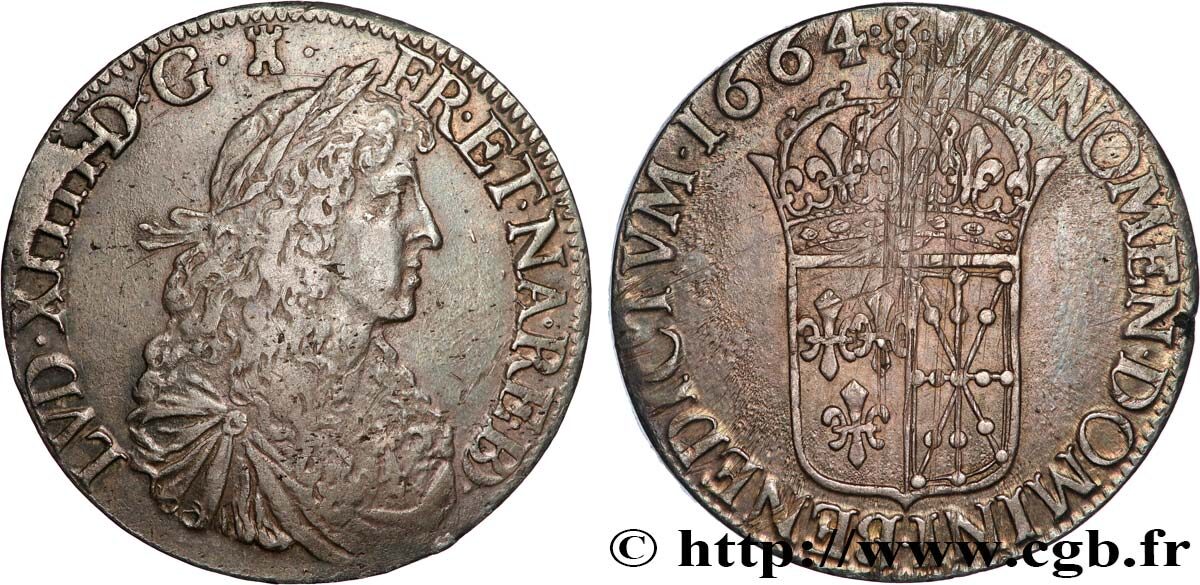
Complete silver shield of Louis XIV, King of France and Navarre, carved in Donapaleu – 27.06gr – 38mm diameter
Found: LVD.XIIII.DG (Tower House) FR.ET.NA.RE DB (The tower house is a characteristic of the engraver, perhaps Jean-Baptiste Dufour)
Obverse: SIT.NOMEN.DOMINI.BENEDICTVM. 1664 (Crossed left) (Unknown mintmark, again Genisseau himself)
1664 – One of the first coins minted in 1664 after the reopening of the Donapaleu mint
CGB Live auction September 2024 24 September 2024
This specimen was part of the Christian Charlet Collection.
All the coins of Donapaleut of this first minting year (1664) bear the text and title DB (Dominus Bearnie), that is, Lord of Bearn. This title historically appeared on the coins struck at the Bearn mints, in Morlaas and Pau, but not on those of Donapaleut, which was the mint of the Kingdom of Navarre and did not mention the sovereign of Bearn.
These historical features of coinage were well known to all local engravers. How can we explain the DB text that appears on all coins minted in Donapaleu in 1664 and to some extent also on those minted in 1665?
The dies used to produce these coins of Donapaleu were not made by a local or Bearn engraver. An engraver from these regions would not have made such a mistake. The royal image of the coins of Donapaleu of these first two years is the same as that of Pau. Pau received the punches and dies from Paris, from the workshop of the chief engraver Jean Warin. During these years, Jean Warin was an assistant to the general engraver of France, as well as an engraver who worked at the Paris mint. His name was Jean-Baptiste Dufour and he had a turret as his characteristic. The coins of Donapaleu of this period show a turret on the obverse.
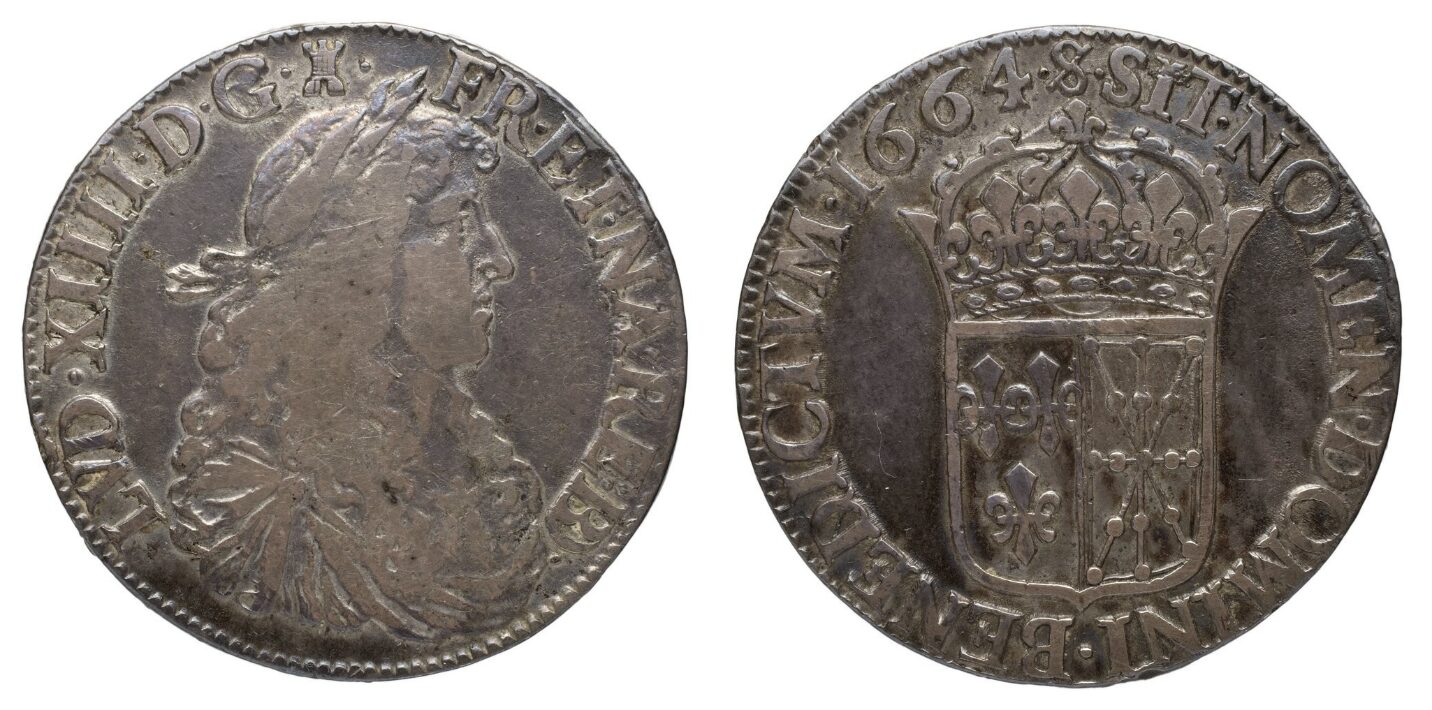
Complete silver shield of Louis XIV, King of France and Navarre, carved in Donapaleu – 26.95gr
Found: LVD.XIIII.DG (Tower House) FR.ET.NA.RE DB (The tower house is a characteristic of the engraver, perhaps Jean-Baptiste Dufour)
Obverse: SIT.NOMEN.DOMINI.BENEDICTVM. 1664 (Crossed left) (Unknown mintmark, again Genisseau himself)
1664 – One of the first coins minted in 1664 after the reopening of the Donapaleu mint
Specimen of the National Library of France (BNF)
The idea that the engraver Jean-Baptiste Dufour, under the orders of the general Jean Warin, had not only made dies and punches but also complete dies for the Donapoleuc mint has been put forward in recent years. Without any knowledge of local customs, and perhaps using as a model one of the coins struck in Pau the previous year, he had created coinage dies with the text DB for the Donapoleuc mint, without realizing his mistake.
The Donapaleu mint began to mint local silver using these dies from Paris in 1664. Another peculiarity of these coins is the characteristic of the mintmaster. In addition to the turret that we have taken as the engraver's characteristic, a crossed S also appears on the obverse. This characteristic belongs to the mintmaster, but unfortunately we do not have the name or other data of the person who was the mintmaster of Donapaleu in these years. Therefore, it has been speculated that this crossed S was the symbol of Genisseau himself, who had the general charter of the French mints. The characteristics of the engraver and mintmaster of the coins minted in Donapaleu in both 1664 and 1665 are stable (there is one small exception as we will see later). The appearance of these special characteristics ends when Claude Thomas, the new general charterer of the French mints, was appointed in February 1666. But we do not have a known specimen from 1666, in the case of the Donapaleu mint, we have to wait until 1667.
The number of coins minted in these first or second minting years after the re-opening is unknown; it would not have been very large, as the known number of coins corresponding to each year that have survived to our days is probably less than ten.
With such a small number of specimens, here are the ones I have found so far, in addition to the two presented earlier.
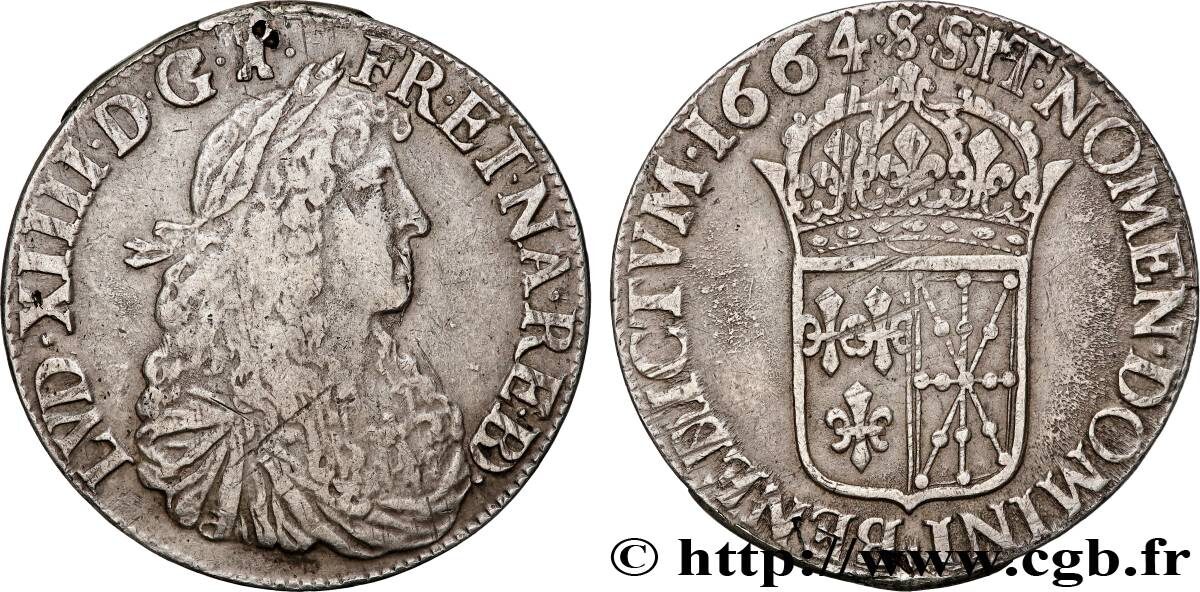
Complete silver shield of Louis XIV, King of France and Navarre, carved in Donapalace – 26.99gr – 39 mm diameter
Found: LVD.XIIII.DG (Tower House) FR.ET.NA.RE DB (The tower house is a characteristic of the engraver, perhaps Jean-Baptiste Dufour)
Obverse: SIT.NOMEN.DOMINI.BENEDICTVM. 1664 (Crossed left) (Unknown mintmark, again Genisseau himself)
1664 – This piece shows traces of welding on the king's figure and turret.
CGB Live auction September 2024 24 September 2024
This specimen was part of the Christian Charlet Collection.
The fourth and last issue of 1664 that I have not yet identified is the following (however, the expert Christian Charlet confirmed that he knew of 5 issues in 1997):

Complete silver shield of Louis XIV, King of France and Navarre, carved in Donapaleu – 26.94gr
Found: LVD.XIIII.DG (Tower House) FR.ET.NA.RE DB (The tower house is a characteristic of the engraver, perhaps Jean-Baptiste Dufour)
Obverse: SIT.NOMEN.DOMINI.BENEDICTVM. 1664 (Crossed left) (Unknown mintmark, again Genisseau himself)
1664 – One of the first coins minted after the reopening of the Donapaleu mint
Patrick Guillard Collection, E-Auction 9-Lot 146 November 11, 2024
In all these specimens, a better quality of coinage can be seen on the obverse sides, while the obverse sides present a lack of depth and definition of the images. We can conclude that the die on the obverse side was mounted on the movable element of the wheel and the one on the obverse side on the fixed element of the wheel. Likewise, many specimens present irregular adjustment lines, especially on the obverse side. The reason and cause of these adjustment lines is not entirely known to me, at least; some say that they are lines made to adjust the silver weight, others that they are caused by testing and quality control… at least they do not appear to have been created during the lamination process, since they appear to be lines made after the coin was minted.
What happened the following year? What can the coins minted in 1665 tell us?
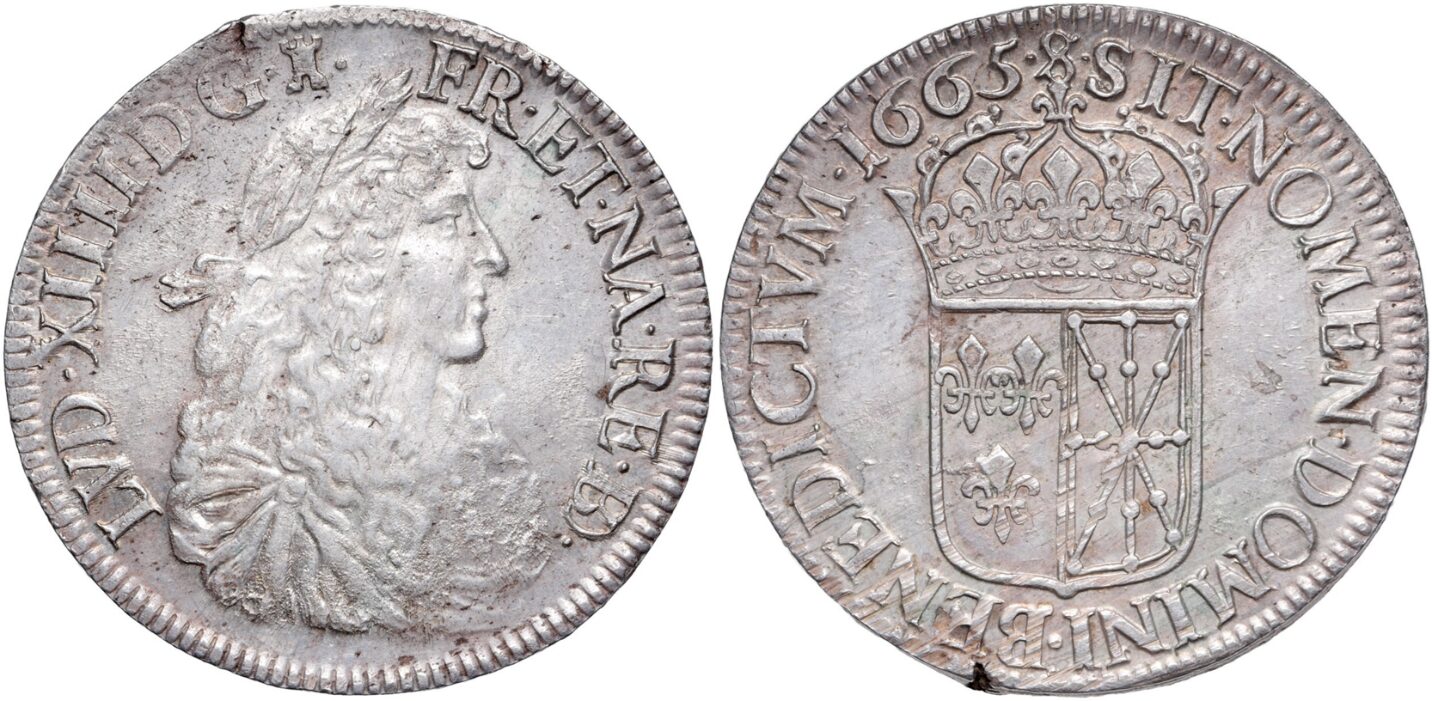
Complete silver shield of Louis XIV, King of France and Navarre, carved in Donapaleu – 27.25gr – 40.6mm diameter – €4250 auction price
Found: LVD.XIIII.DG (Tower House) FR.ET.NA.RE DB (The tower house is a characteristic of the engraver, perhaps Jean-Baptiste Dufour)
Obverse: SIT.NOMEN.DOMINI.BENEDICTVM. 1665 (Crossed left) (Unknown mintmark, again Genisseau himself)
1665 – One of the coins that maintains the same pattern as the coins minted the previous year
De Baeque Marseille March 2025 Auction Lot 432 20.03.2025
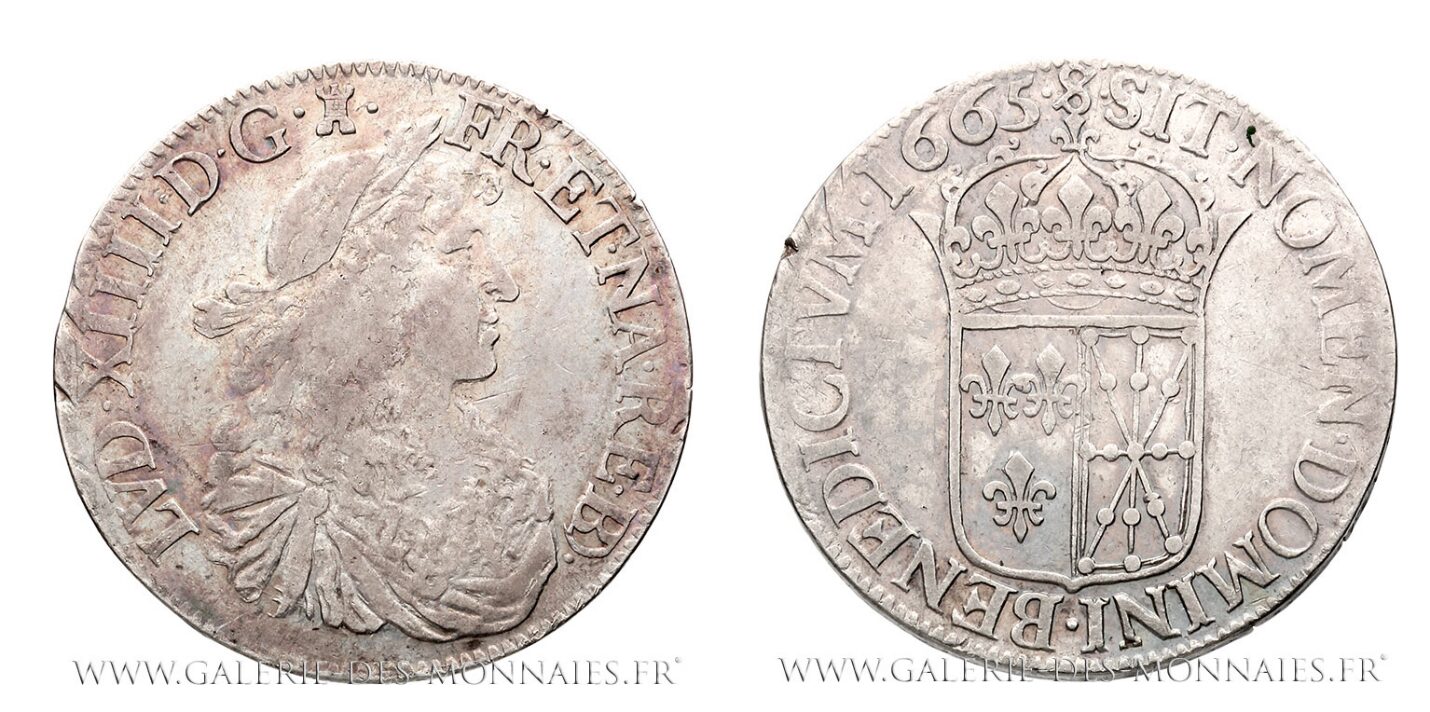
Complete silver shield of Louis XIV, King of France and Navarre, carved in Donapaleus – 26.86gr – 39.2mm diameter – €4950 auction price
Found: LVD.XIIII.DG (Tower House) FR.ET.NA.RE DB (The tower house is a characteristic of the engraver, perhaps Jean-Baptiste Dufour)
Obverse: SIT.NOMEN.DOMINI.BENEDICTVM. 1665 (Crossed left) (Unknown mintmark, again Genisseau himself)
1665 – One of the coins that maintains the same pattern as the coins minted the previous year
Galerie des monnaies Lot 1490 14.02.2017
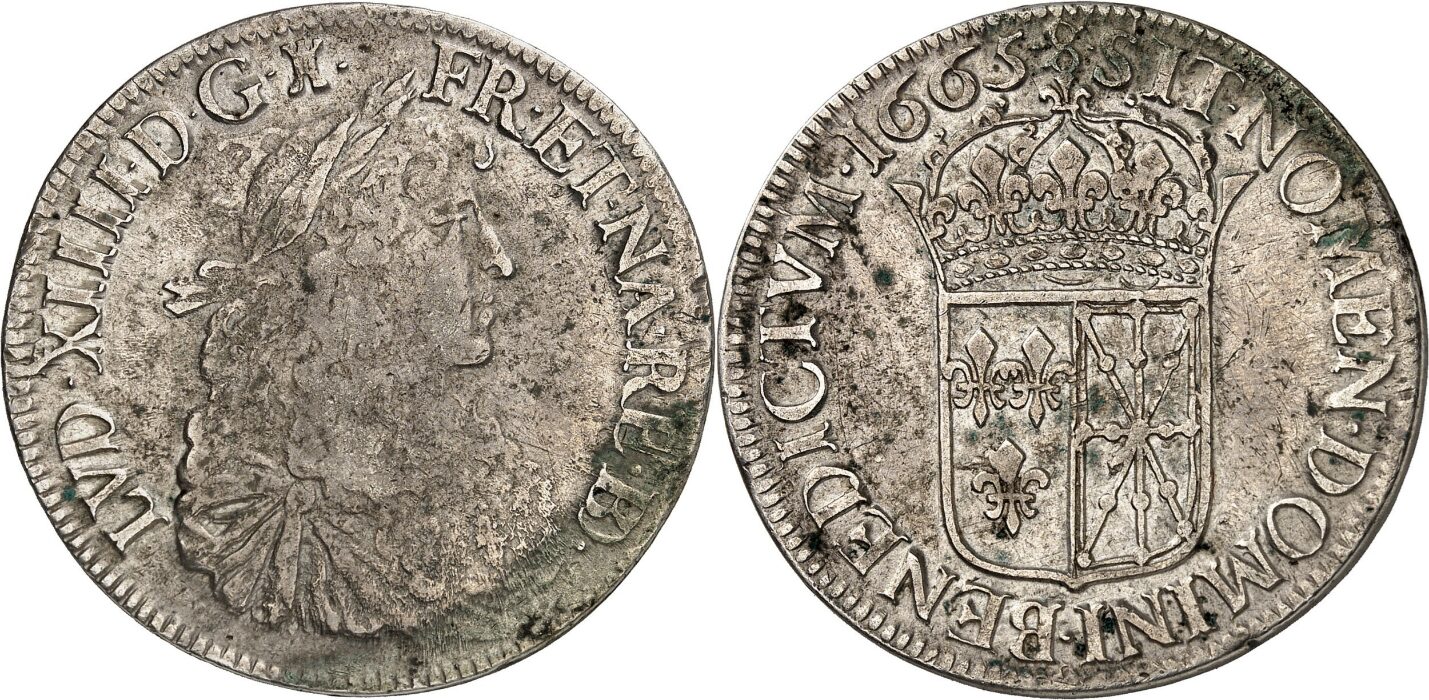
Complete silver shield of Louis XIV, King of France and Navarre, carved in Donapaleus – 27.14gr – 39.5mm diameter
Found: LVD.XIIII.DG (Tower House) FR.ET.NA.RE DB (The tower house is a characteristic of the engraver, perhaps Jean-Baptiste Dufour)
Obverse: SIT.NOMEN.DOMINI.BENEDICTVM. 1665 (Crossed left) (Unknown mintmark, again Genisseau himself)
1665 – One of the coins that maintains the same pattern as the coins minted the previous year
MDC Monaco Auction 15 Lot 796 23-24 Oct 2024
The first three coins presented follow the same pattern as those minted the previous year, bearing the title DB (Dominus Bearnie), along with the turret and crossed S features. The year of issue is, of course, 1665, the year of issue following 1664. The dies used in the minting of these coins have the same features as those minted the previous year; this would confirm the belief that they came from Paris.
But now, we must look at these subsequent copies. The first has always been in the National Library of Paris, and until recently we all believed that it was the only known copy, made in 1666.
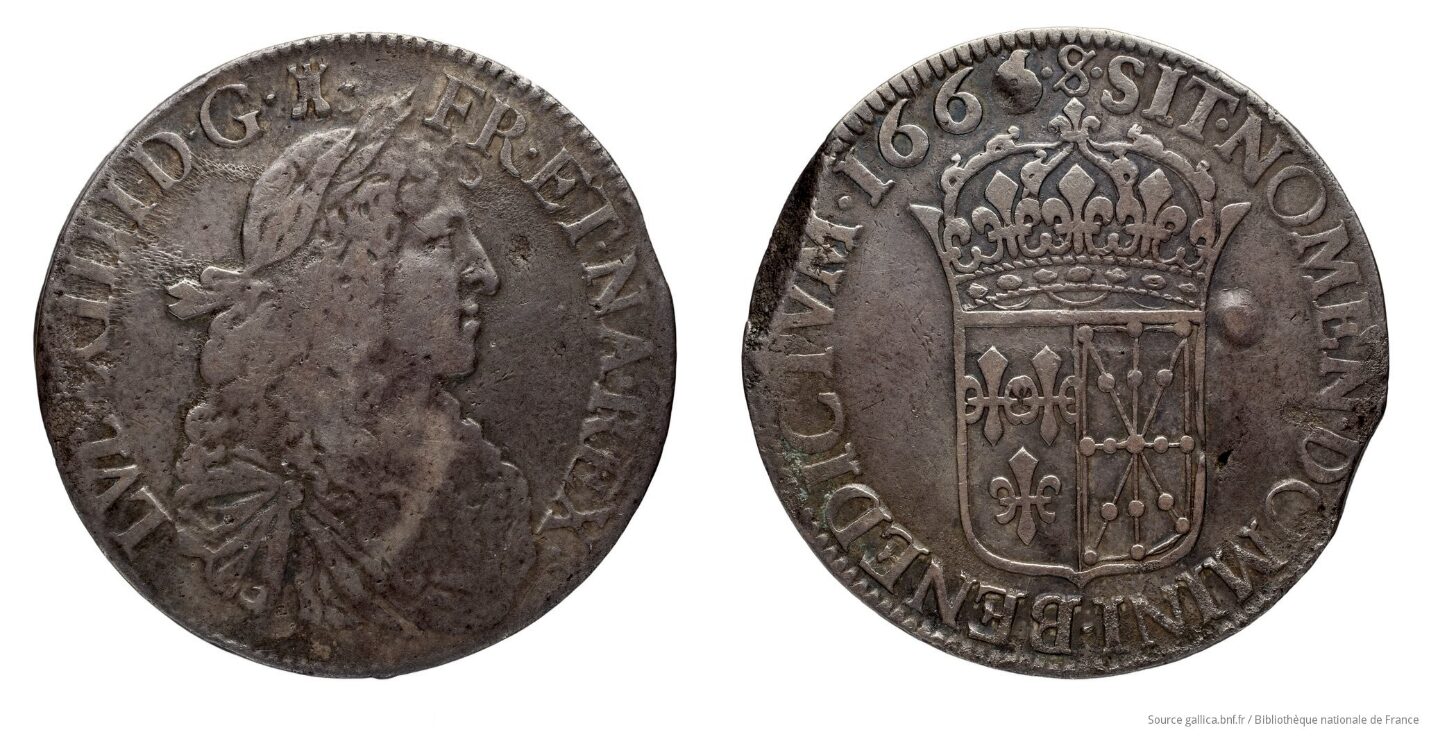
Complete silver shield of Louis XIV, King of France and Navarre, carved in Donapaleu – 26.68gr
Found: LVD.XIIII.DG (Tower House) FR.ET.NA.REX (The tower is a characteristic of the engraver, perhaps Jean-Baptiste Dufour)
Obverse: SIT.NOMEN.DOMINI.BENEDICTVM. 1666/1665 (Crossed left) (Although it looks like the year 1666, it is actually the year 1665)
1665 – Issue with the full Latin word REX instead of the title DB
National Library of France (BNF)
But a coin sold at auction in 2001, the one we will see at the end of this entry, led the expert Christian Charlet to come up with a new hypothesis. In the process of testing this hypothesis, Charlet re-examined the coin kept in the French National Library. After a closer examination, he concluded that the last digit of the year, which we thought was a six, was actually a five filled with excess metal. He therefore learned that this coin belonged to the Donapaleu workshop of 1665.
The following specimen, which I recently saw at auction, has reinforced the opinion of expert Christian Charlet. This specimen is said to have been part of Christian's own collection:
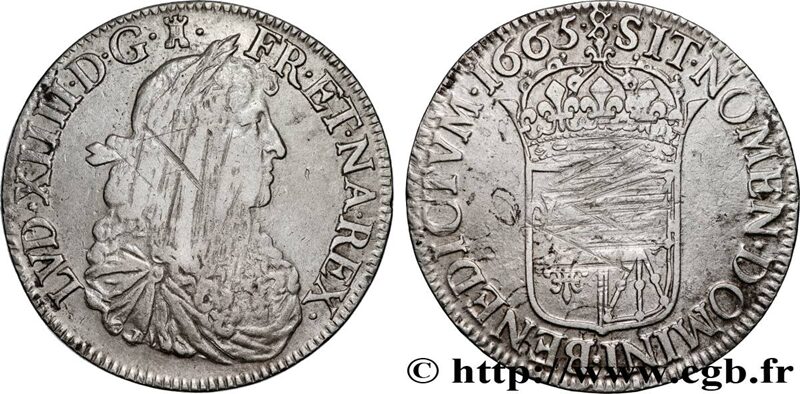
Complete silver shield of Louis XIV, King of France and Navarre, carved in Donapalace – 27.22gr – 39 mm diameter
Found: LVD.XIIII.DG (Tower House) FR.ET.NA.REX (The tower is a characteristic of the engraver, perhaps Jean-Baptiste Dufour)
Obverse: SIT.NOMEN.DOMINI.BENEDICTVM. 1665 (Crossed left) (year 1665 clearly visible)
1665 – Issue with the full Latin word REX instead of the title DB
CGB Live auction June 2025 03 June 2025
The coins minted in 1665 are the last coins minted at Donapaleu under Genisseau's contract. The following year, on 28 January 1666, the royal council suspended Genisseau's general contract. There are no traces of Donapaleu coins from 1666, and the coins minted under the new mintmaster Jean D'Armagnan, who worked under the general manager Claude Thomas, who received the new contract, bear the mark of 1667 for the first time.
But before that happens, there are two other significant copies that show the year 1665. The photograph of the second copy was sent to Christian Charlet by the expert Francesco Pastrone (Editions Gadoury) in 2000 (I do not have a photograph of this copy at the moment). The first copy, which was auctioned in 2001, is the one that appears next.
The appearance of these two specimens changed Charlet's previous opinion about the development of the coinage of Donapaleu between 1664 and 1666. As previously mentioned, after re-examining the specimen in the Bibliothèque Nationale in Paris, he learned that it did not correspond to the year 1666.
Likewise, the 1665 copies, which follow the same DB pattern as the previous copies produced in 1664, confirmed that they were the first to be produced chronologically. These would be followed by those showing the full text REX instead of the title RE and DB, as shown in the previous photographs.
This would prove that the Parisian engraver became aware of the error during 1665 and prepared new dies, or rather, new matrices and punches, for the Donapaleu mint. With these new tools, the coins bearing the correct REX designation were minted.
But how can we then explain the appearance of this latest specimen?
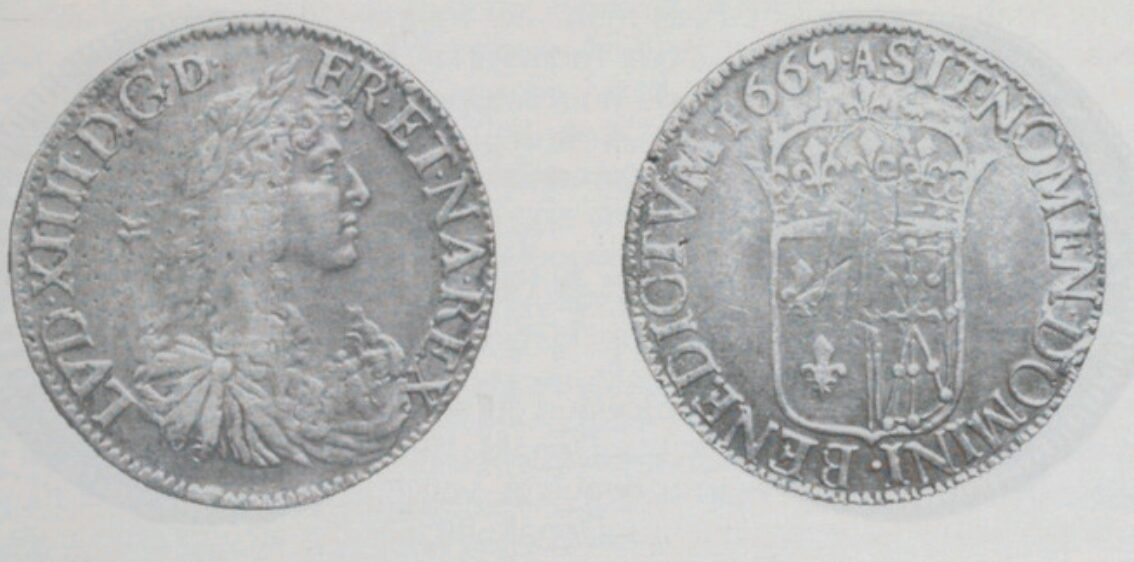
Complete silver shield of Louis XIV, King of France and Navarre, carved in Donapaleu – 27.06gr
Found: LVD.XIIII. DGD FR.ET.NA.REX (Instead of the tower house, the letter D could perhaps be named after Jean-Baptiste Dufour)
Ifrentzua: SIT.NOMEN.DOMINI.BENEDICTVM. 1665 A (The crossed S is replaced by an A. The A is the hallmark of the Paris mint) (The number 5 of the year 1665 is from the Donapaleu coin minted in the previous decade)
1665 – Issue showing the full Latin word REX instead of the title DB
Vente A. Weil, Paris-Drouot, Lot 183 Mars 27 2001
This latest issue, and the other similar issues from 2000 mentioned earlier, present three notable peculiarities.
- Instead of the tower, which is the engraver's signature, they show a D-shaped letter, perhaps again a reference to Jean Baptiste. Dufour What informs the host?
- Instead of the crossed letter S of the mintmaster, they show the letter A. According to the letter system of the French kingdom, the letter A designated the mintmaster of Paris.
- The way the number 5 of 1665 was made is similar to the number 5 punches used by local engravers in Donapaleu in the previous decade. See the following example.
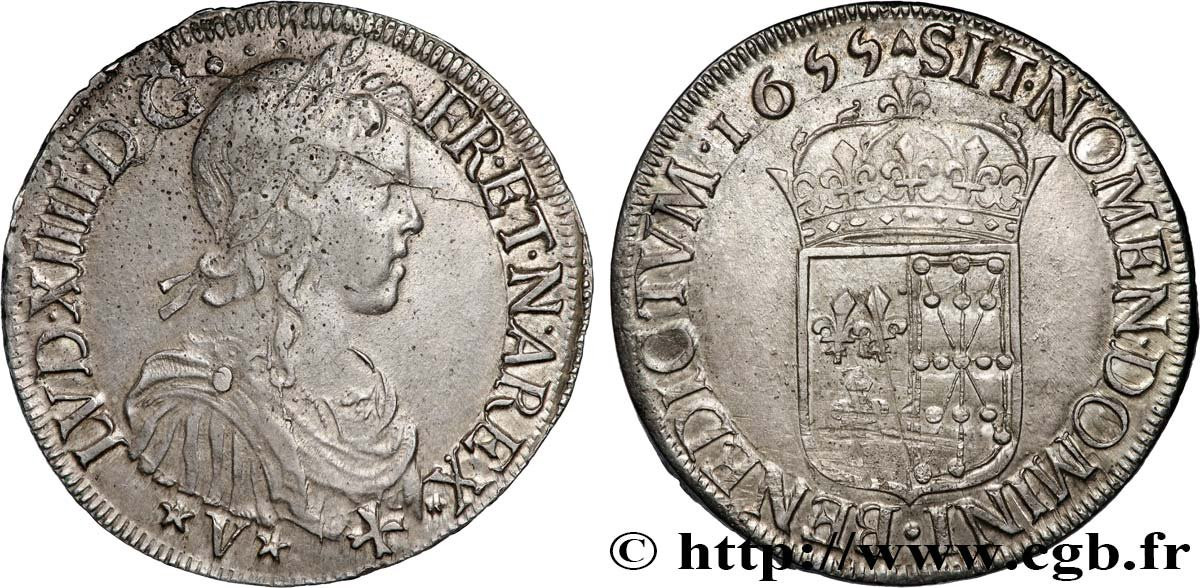
Complete silver shield of Louis XIV, King of France and Navarre, carved in Donapalace – 27.24gr, 39.5mm diameter
Obverse: LVD.XIIII. DG… FR.ET.NA.REX (V Izkia, mintmaster Jean Verdoye)
Obverse: SIT.NOMEN.DOMINI.BENEDICTVM. 1655 (Heart) (Heart engraver Simon d'Armagnac)
CGB.fr, Live Auction September 2023, Lot 847824 05.09.2023
What event led to the production of these two specimens? Chronologically, if we accept that they are the last model of coins minted during 1665, we can say that at some point the punches that produced the tower house, the crossed S and the image of the number 5 on the dies became dull. Perhaps only the punch that produced the number 5 became dull (and the specimen in the Bibliothèque Nationale de France in Paris would be a witness to this event), but as they were changing the design of the legal dies, the workers of Donapaleu decided to change the images of the mintmaster and the engraver. These workers probably still had surplus silver to work with and used the old local punches to make a last pair of usable dies. With these pairs of dies, they made a final mintage of coins like the two specimens we know of. The coins of this last mintage had the year 1665 on all the specimens and therefore there is no trace of any specimen showing the year 1666.
The small letter D would like to continue to designate the engraver Jean Baptiste Dufoir, while the letter A would perhaps refer to the punches and dies brought from Paris, who knows. But it is also possible that these letters D and A belong to the mintmaster Jean D'armaignan, since it was this D'armaignan who would restart coinage towards the end of 1666 under the command of Claude Thomas, then using the symbol of a heart.
In this entry, I have shown all the coins of Donapaleu that I know of from 1664 and 1665. I still don't have the whereabouts or photos of a few of them, but we can say this.
Although no mintage records from these two minting years have survived, the number of coins that have survived to our days is very limited. The known number of coins from each year is probably less than ten, and anyone who owns one of these coins should consider themselves lucky.
Bibliography:
Les monnaies béarnaises de Louis XIV (I) – Christian Charlet – 2012 – link
Les monnaies béarnais de Louis XIV (II) – Christian Charlet – 2014 – link
Ferneture et réouverture des monnaies de Navarre et Béarn en 1662-1663 – Fernand Arbez, Christian Charlet – 1997 – link
Fantaisies béarnaises à Saint-Palais au temps de Colbert – BSFN, 2007 – Christian Charlet – link
The Silver Crowns of France, 1641-1973 – George Sobin Jr, 1974
Les frappes monétaires en Béarn et Basse-Navarre d'après les comptes conservées aux Archives départementales des Basses-Pyrénées - Francoise Dumas - 1959 - link
